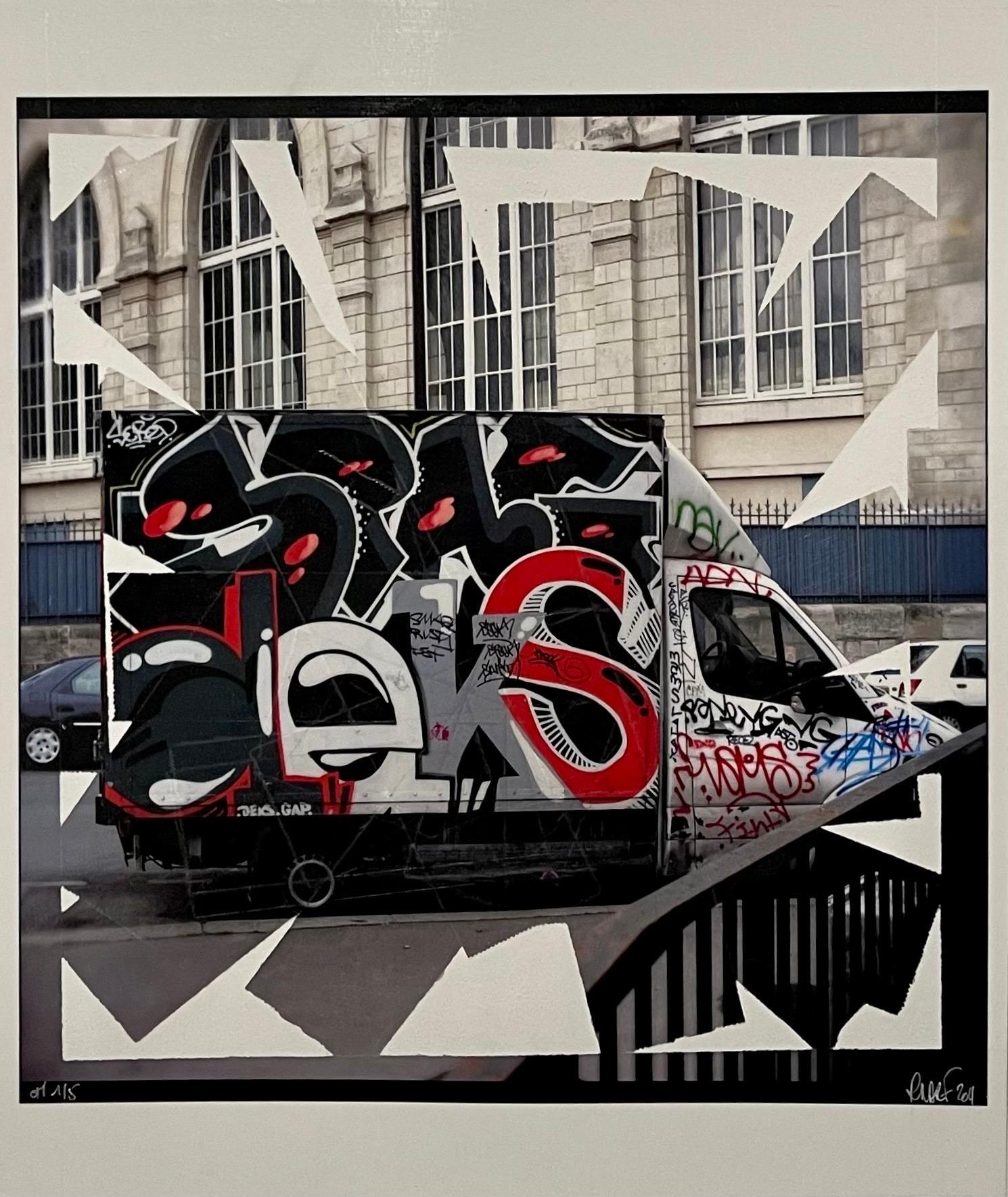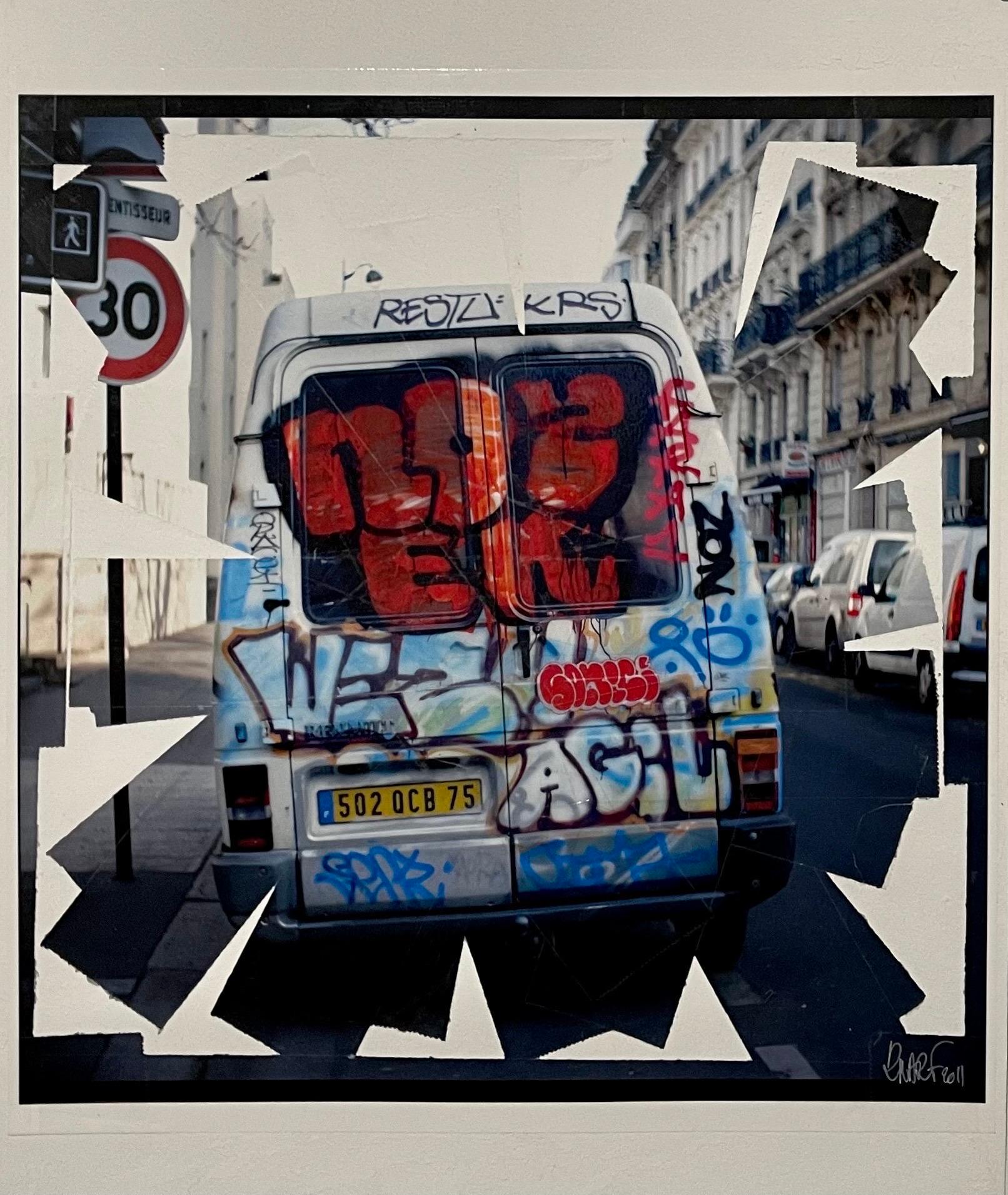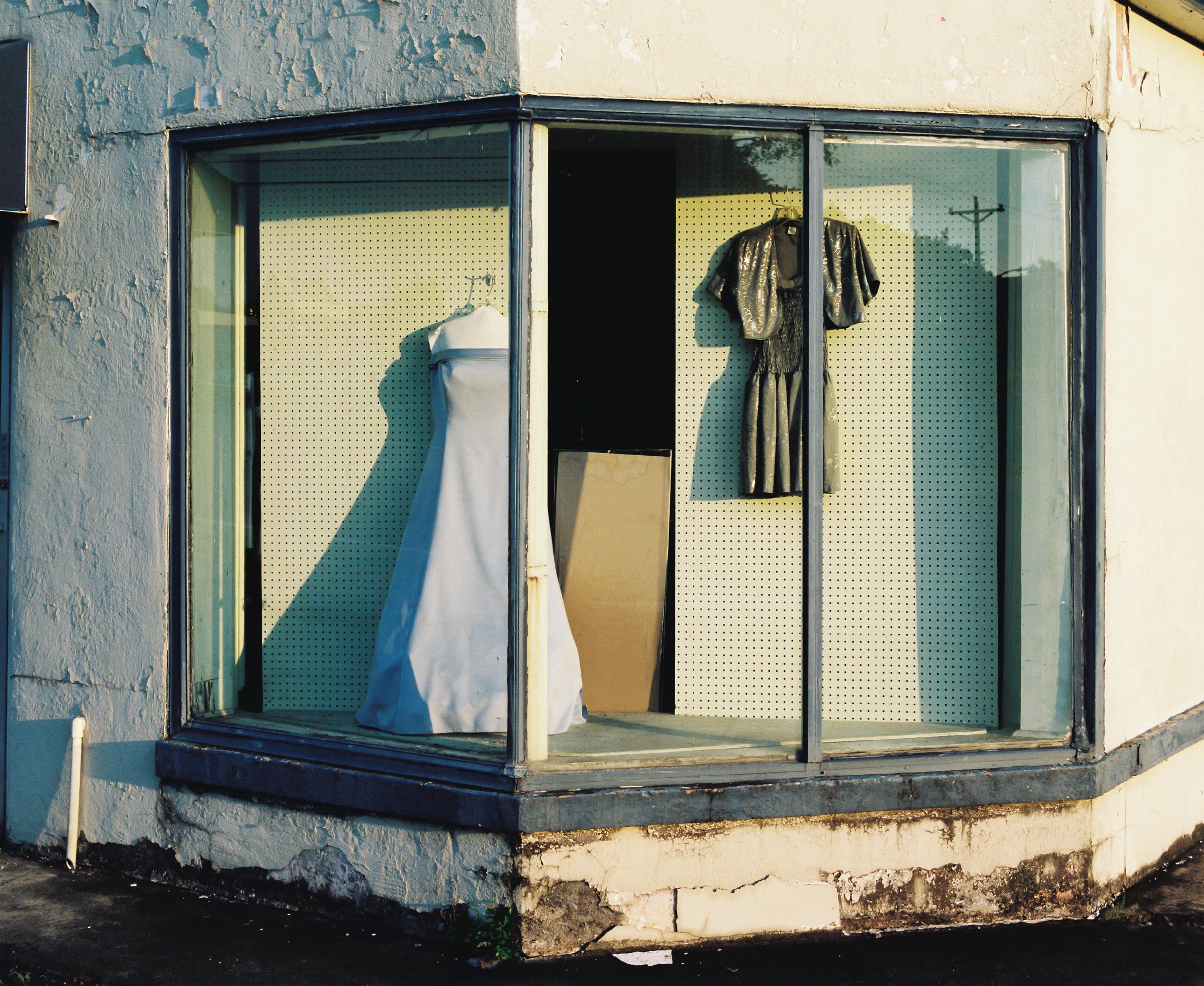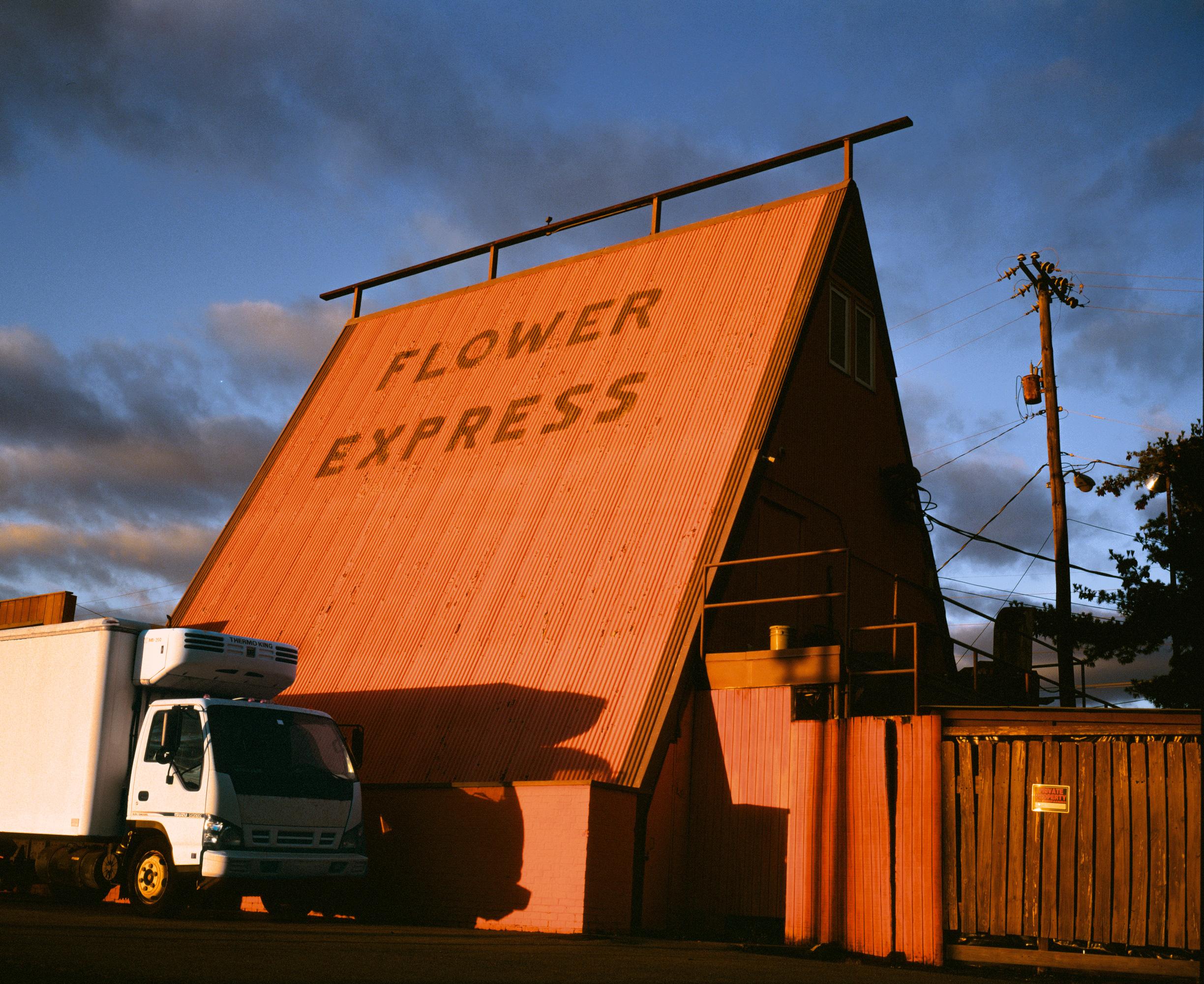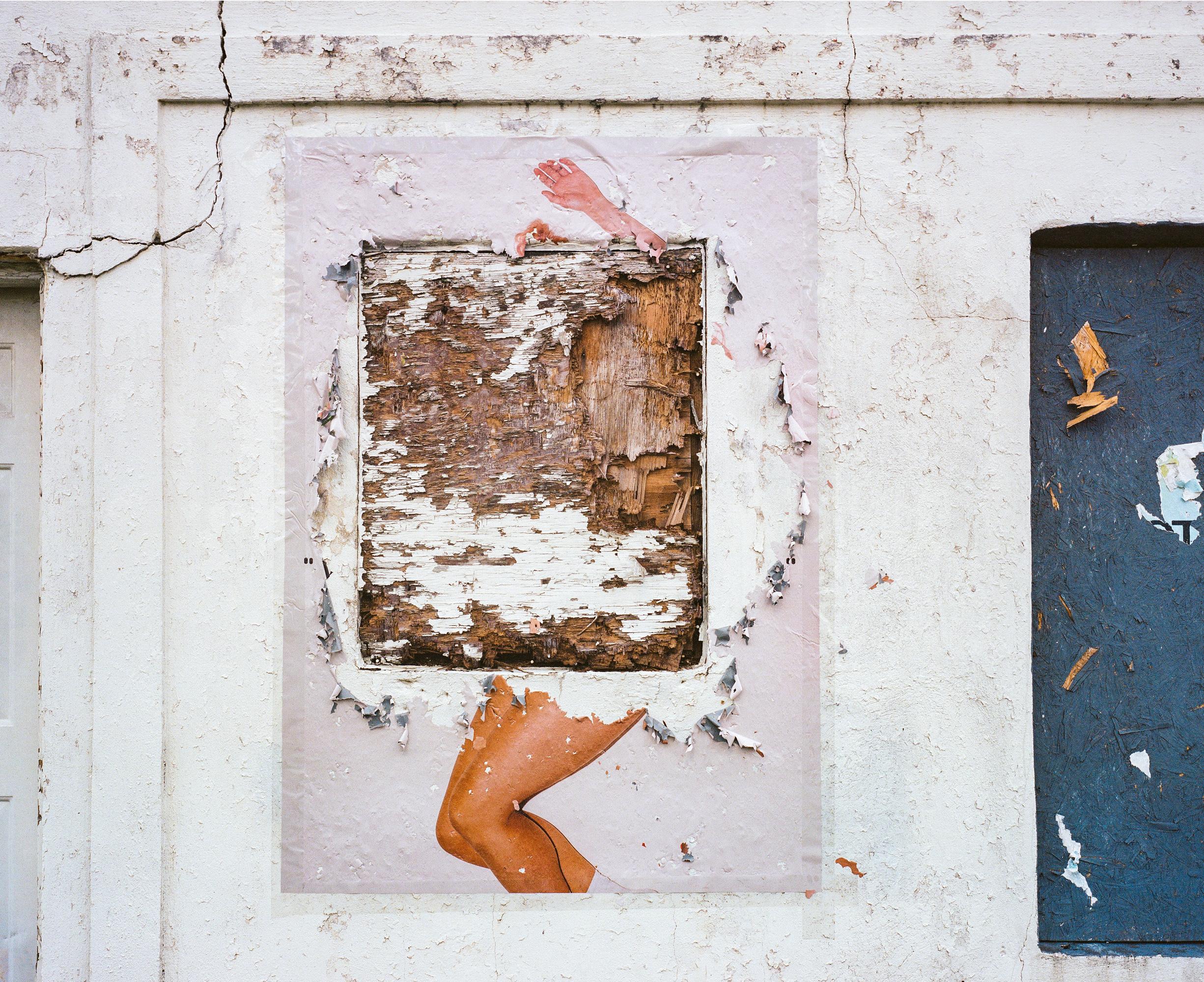Items Similar to K-Narf Color Photo Graffiti, Adhesive Tape Altered Street Art Photograph Collage
Want more images or videos?
Request additional images or videos from the seller
1 of 13
K-NarfK-Narf Color Photo Graffiti, Adhesive Tape Altered Street Art Photograph Collage
About the Item
K-narf, French (b. 1970)
Collage photo artwork (Graffiti Vans) (2011)
Tape-o-graph photography
Signed lower right, numbered 1/5
16 x 12 7/8 inches
K-NARF was born in 1970 in Saint-Etienne, France and now lives in Tokyo.
K-NARF invented PHOTOGRAFFITI a contemporary way of making street photography that lead him to develop his singular Tape-o-Graphy technique. It involves the application of adhesive tape strips on developed photographs in order to manually process the photographs giving them a unique surface texture and extraordinary appearance.
Open to influences from street art and video, he uses the medium of photography as a toy to create and play. Both conceptual and experimental, definitely non-conventional, his work documents, recycles and collects the visual anachronisms of a world in a perpetual mutation. Through the years, K-narf often got support from key figures of the art world such as Teruo Kurosaki (Idee, Tokyo), Rotraut and Daniel Klein-Moquay (Yves Klein Estate), Joel Meyerowitz (pioneer of contemporary color photography), Jacques Attali (French writer), Olivier Gay (Architect & Art collector) and Yoichi Nakamuta (curator & Art producer). He collaborates on regular basic with established Art galleries including the Clic gallery in NYC, the 0fr gallery and Molin Corvo gallery in Paris or the Clear gallery in Tokyo. He moved back to Tokyo early 2014 and created his own gallery/atelier in the heart of the Nakameguro.
For the past decade K-narf has lived and exhibited worldwide including Japan, Australia, France, Singapore, USA and Italy. His exhibitions, often taking the form of ephemeral installations, are shown without distinction in a plant still in operation, an old theatre, Art galleries, Art biennales or an abandoned garage. His work has been shown atthe Museum of Contemporary Art in Scottsdale (US), the Museum of Sydney, the Japan Foundation for the Arts, The Yves Klein Archives, Agnes B, Pierre Herme, Issey Miyake (Paris), the Clic gallery in NYC as well as a solo show during the Arles photo festival. K-NARF has exhibited his “photograffiti” installations in unlikely locations such as old cinemas, functioning plants, and abandoned garages. But he’s no street art snob. He has also shown his work at the French Embassy in Tokyo, the Museum of Sydney, and a photo festival in Arles, France. His career was launched back in 2001 when an artist named Teruo Kurosaki gave K-NARF — then a practicing architect — his first exhibition, The Red and Newspapers, at Sputnik PAD in Tokyo, Japan. Since then, he has been honing his creations and is seemingly primed to join the neo-pop ranks of cynical self-merchandising artists Jeff Koons and Takashi Murakami.
K-Narf Photograffiti was exhibited at Clic Gallery NYC; kitschy photographs of amusement parks from the ’80s that he then altered with adhesive tape. French artist K-NARF transformed the concept of hatarakimono into a stunning series of works, photographing Japan’s everyday workers on the street in their work clothes. Using a portable background, he created an identical structure for all of the images. He posed bus drivers, souvenir shop cashiers, and udon cooks on a small pedestal in front of a gray background. The result is stunning: K-NARF has created a multi-faceted monument to the workers. With the HATARAKIMONO, K-NARF picks up right in the famous footsteps of of photographers Felix Thiollier, August Sander or Irving Penn. K-NARF & SHOKO go against the grain and shows Japan’s traditional workers in their everyday outfits without special clothing or make-up. They do not use filters to iron out the wrinkles in their suits or faces. When selecting the unusual format for the project, the artist took inspiration from an old photo art tradition. The portraits are reminiscent of the carte de visite, a kind of small photographic calling card from the 1860s that helped photography make major breakthroughs in popularity. Knarf describes himself as an artist pretending to be a photographer. He is self-taught in the art and craft of photography. As a 15 year-old, he installed a makeshift darkroom in his parents’ bathroom to develop his first black-and-white photos. In 1996, after he acquired one of the first digital camera, he started a new approach to photography blending up-coming technologies together with manual processing techniques. He had his first exhibition in Tokyo in 2001 and in 2005 IdN, Hong-Kong publisher, released NEO-PHOTO a book dedicated to his work. K-NARF met SHOKO in Tokyo in 2014, they started working together in 2016 with the HATARAKIMONO PROJECT. It was first presented in 2018 at the Kyotographie International Photography Festival. This work owes a debt to Arte Povera and Bricolage a French form of collage (ala Tom Sachs),
BIO
1970 Born in Saint-Etienne, France
2001 move to Tokyo, first exhibition in Japan at SPUTNIK-IDÉE in Tokyo
2006 invited to be one of the 40 first members of the prestigious “HP Influencers program”. (He is the youngest member on the side with MAGNUM photographers and other established photographers such as Joel Meyerowitz)
2007 solo exhibition at the Rencontres d’Arles international photo festival
2008 invents PHOTOGRAFFITI as a new street photography approach and start pasting them in the streets of
Tokyo, Paris, Milan, Rome, NYC
2010 starts making his first large format TAPE-O-GRAPHS
2011 first exhibition in the USA, CLIC Gallery NYC
2014 move back his studio to Tokyo and meet SHOKO
2016 Began working on the HATARAKIMONO project together with japanese artist, Shoko Yamaguchi
2018 HATARAKIMONO PROJECT book co-published with DILECTA Editions, Paris
2019 started the “PLASTÉONTOLOGY PROJECT” in collaboration with TARA OCEAN FOUNDATION (Agnès b)
2020 K-NARF & SHOKO moved their studio from Tokyo to Kyoto
- Creator:K-Narf (1971, American)
- Dimensions:Height: 16 in (40.64 cm)Width: 12.88 in (32.72 cm)
- Medium:
- Movement & Style:
- Period:
- Condition:
- Gallery Location:Surfside, FL
- Reference Number:1stDibs: LU38210135562
About the Seller
4.9
Platinum Seller
These expertly vetted sellers are 1stDibs' most experienced sellers and are rated highest by our customers.
Established in 1995
1stDibs seller since 2014
1,549 sales on 1stDibs
Typical response time: 1 hour
- ShippingRetrieving quote...Ships From: Surfside, FL
- Return PolicyA return for this item may be initiated within 3 days of delivery.
More From This SellerView All
- K-Narf Color Photo Graffiti, Adhesive Tape Altered Street Art Photograph CollageBy K-NarfLocated in Surfside, FLK-narf, French (b. 1970) Collage photo artwork (Graffiti Vans) (2011) Tape-o-graph photography Signed lower right, numbered 1/5 16 x 12 7/8 inches K-NARF was born in 1970 in Saint-Etienne, France and now lives in Tokyo. K-NARF invented PHOTOGRAFFITI a contemporary way of making street photography that lead him to develop his singular Tape-o-Graphy technique. It involves the application of adhesive tape strips on developed photographs in order to manually process the photographs giving them a unique surface texture and extraordinary appearance. Open to influences from street art and video, he uses the medium of photography as a toy to create and play. Both conceptual and experimental, definitely non-conventional, his work documents, recycles and collects the visual anachronisms of a world in a perpetual mutation. Through the years, K-narf often got support from key figures of the art world such as Teruo Kurosaki (Idee, Tokyo), Rotraut and Daniel Klein-Moquay (Yves Klein Estate), Joel Meyerowitz (pioneer of contemporary color photography), Jacques Attali (French writer), Olivier Gay (Architect & Art collector) and Yoichi Nakamuta (curator & Art producer). He collaborates on regular basic with...Category
Early 2000s Street Art Color Photography
MaterialsAdhesive, Tape, Mixed Media, Photographic Paper
- K-Narf Color Photo Graffiti, Adhesive Tape Altered Street Art Photograph CollageBy K-NarfLocated in Surfside, FLK-narf, French (b. 1970) Collage photo artwork (Graffiti Vans) (2011) Tape-o-graph photography Signed lower right, (this one is not editioned and might be unique. the other 2 I have were from an edition of 5) 16 x 12 7/8 inches K-NARF was born in 1970 in Saint-Etienne, France and now lives in Tokyo. K-NARF invented PHOTOGRAFFITI a contemporary way of making street photography that lead him to develop his singular Tape-o-Graphy technique. It involves the application of adhesive tape strips on developed photographs in order to manually process the photographs giving them a unique surface texture and extraordinary appearance. Open to influences from street art and video, he uses the medium of photography as a toy to create and play. Both conceptual and experimental, definitely non-conventional, his work documents, recycles and collects the visual anachronisms of a world in a perpetual mutation. Through the years, K-narf often got support from key figures of the art world such as Teruo Kurosaki (Idee, Tokyo), Rotraut and Daniel Klein-Moquay (Yves Klein Estate), Joel Meyerowitz (pioneer of contemporary color photography), Jacques Attali (French writer), Olivier Gay (Architect & Art collector) and Yoichi Nakamuta (curator & Art producer). He collaborates on regular basic with...Category
Early 2000s Street Art Color Photography
MaterialsAdhesive, Tape, Mixed Media, Photographic Paper
- 1970s Mona Lisa Photo Collage Photograph Pioneer Female Aviator Feminist Pop ArtBy Vera SimonsLocated in Surfside, FLThis one Mona Lisa, some with glasses drawn on, cut and torn newspaper, collage, assemblage and looks like a Guerrilla Girl ad in a pattern and decoration style. It is not signed or ...Category
1970s Assemblage Color Photography
MaterialsMixed Media, Newsprint, Photographic Paper
- Vintage C Print "Of Time and Change" Boulders on a Sea ShoreBy Sonja BullatyLocated in Surfside, FL1981, Chromogenic Print. It is supposed to be signed lower right recto but has not been examined out of frame. Provenance: Bernice Steinbaum Gallery, New York; ARCO Chemical Company, Newtown Square, PA. Sonja Bullaty (October 17, 1923 - October 5, 2000) was a Jewish American photographer. Bullaty is known for her "lyrical composition" and strong use of color during her fifty-year collaboration with her husband, Angelo Lomeo. Bullaty and Lomeo's photographs appeared in LIFE, Time and Audubon magazines and journal.They have both exhibited at the Metropolitan Museum of Art, the International Center of Photography, the George Eastman House, UMPRUM Museum in Prague, in the Nikon House galleries and other venues. Bullaty was born in Prague to a Jewish banking family. Her family gave her a camera when she turned fourteen. Since Bullaty had been forced to leave school at the time, the camera was a "consolation gift." When Bullaty was eighteen, she was deported by the Nazis to Poland, where she was kept in the Lodz ghetto, and then later taken to Auschwitz and Gross-Rosen concentration camps. During a death march near Dresden, she and a friend successfully hid in a barn and were able to escape and return to Prague. When she got back to her home city, she discovered that no one else in her family had survived the Holocaust. Bullaty, "her head shaved," saw and answered an advertisement to be the helper to Czech photographer, Josef Sudek. As his assistant, she mixed chemicals for the darkroom, organized his negatives and learned from his sense of composition.[1] Sudek called her his "apprentice-martyr." Sudek's work often focused on the Czech landscape and windows, such as in the series The Windows of My Studio (1940-1954). Bullaty also photographed windows, but unlike Sudek, who photographed his own windows looking out, Bullaty photographed windows looking into buildings. Bullaty published a book, Sudek (1978), about her mentor, and it was the first publication of his work in the West. Bullaty found work with a photographer on her third day in New York. Also in 1947, she met Angelo Lomeo. They were brought together when she was inquiring about a darkroom in a building he managed. Lomeo was intrigued by Bullaty's accent and went to see her. They started photographing together a year later, traveling and sharing resources; during their time together, they became close. Bullaty and Lomeo were married in 1951. Later, when she was married, she and her husband would visit Sudek and bring him photography supplies. They visited him in Czechoslovakia "almost yearly." In 1971, she helped mount an exhibition of Sudek's work in New York. As photographers, Bullaty and Lomeo started using studio cameras...Category
1980s American Modern Color Photography
MaterialsPhotographic Paper, C Print
- Tuscany, Sleeping Woman, 1996 Large Vintage Color Photograph C-Print SignedBy Joel MeyerowitzLocated in Surfside, FLMeyerowitz first drew acclaim for his remarkable ability to capture subtlequalities of light with the 1978 publication of Cape Light, which went on to become a color photography classic, selling more than 130,000 copies. This evocative new collection of images and commentary invites readers to experience the essence of Tuscany; sunlight gilding fields of ripe wheat, darkness lowering under threatening summer skies, and townspeople riding their bicycles through the dappled streets. For those who appreciate the beauty of the Italian landscape and for lovers of photography everywhere,Tuscany is a personal and loving portrait of a truly unforgettable place.Joel Meyerowitz (born March 6, 1938) is a street photographer, and portrait and landscape photographer. He began photographing in color in 1962 and was an early advocate of the use of color during a time when there was significant resistance to the idea of color photography as serious art. In the early 1970s he taught the first color course at the Cooper Union in New York City where many of today's renowned color photographers studied with him. Inspired by seeing Robert Frank at work, Meyerowitz quit his job as an art director at an advertising agency and took to the streets of New York City with a 35mm camera and black-and-white film, alongside Garry Winogrand, Tony Ray...Category
1990s American Modern Landscape Photography
MaterialsPhotographic Paper, C Print
- Tuscany, Field of Poppies, 1996 Large Vintage Color Photograph C Print SignedBy Joel MeyerowitzLocated in Surfside, FLMeyerowitz first drew acclaim for his remarkable ability to capture subtlequalities of light with the 1978 publication of Cape Light, which went on to become a color photography classic, selling more than 130,000 copies. This evocative new collection of images and commentary invites readers to experience the essence of Tuscany; sunlight gilding fields of ripe wheat, darkness lowering under threatening summer skies, and townspeople riding their bicycles through the dappled streets. For those who appreciate the beauty of the Italian landscape and for lovers of photography everywhere,Tuscany is a personal and loving portrait of a truly unforgettable place.Joel Meyerowitz (born March 6, 1938) is a street photographer, and portrait and landscape photographer. He began photographing in color in 1962 and was an early advocate of the use of color during a time when there was significant resistance to the idea of color photography as serious art. In the early 1970s he taught the first color course at the Cooper Union in New York City where many of today's renowned color photographers studied with him. Inspired by seeing Robert Frank at work, Meyerowitz quit his job as an art director at an advertising agency and took to the streets of New York City with a 35mm camera and black-and-white film, alongside Garry Winogrand, Tony Ray...Category
20th Century Landscape Photography
MaterialsPhotographic Paper, C Print
You May Also Like
- Patrick Sansone, Sue's Window, 2021, Lambda C Print, Ed 2/10, Street PhotographyLocated in Darien, CTPatrick Sansone uses analog cameras and film to create photographs that reference stillness, lure, and intermission. Decaying signage, abandoned industrial sites, and defunct storefr...Category
2010s Street Art Color Photography
MaterialsArchival Paper, Photographic Paper, C Print, Color, Lambda
- Patrick Sansone, Flower Express, 2022, Lambda C Print, Ed 1/10, PhotographyLocated in Darien, CTPatrick Sansone uses analog cameras and film to create photographs that reference stillness, lure, and intermission. Decaying signage, abandoned industrial sites, and defunct storefr...Category
2010s Street Art Color Photography
MaterialsArchival Paper, Photographic Paper, C Print, Color, Lambda
- Patrick Sansone, Shelby Legs, 2021, Lambda C Print, Ed 1/10, Street PhotographyLocated in Darien, CTPatrick Sansone uses analog cameras and film to create photographs that reference stillness, lure, and intermission. Decaying signage, abandoned industrial sites, and defunct storefr...Category
2010s Street Art Color Photography
MaterialsArchival Paper, Photographic Paper, C Print, Color, Lambda
- Patrick Sansone, Musicians Only, 2021, Lambda C Print, Ed 1/10, PhotographyLocated in Darien, CTPatrick Sansone uses analog cameras and film to create photographs that reference stillness, lure, and intermission. Decaying signage, abandoned industrial sites, and defunct storefr...Category
2010s Street Art Color Photography
MaterialsArchival Paper, Photographic Paper, C Print, Color, Lambda
- Patrick Sansone, St. Roch and Bird, 2022, Lambda C Print, Ed 1/10, Street PhotoLocated in Darien, CTPatrick Sansone uses analog cameras and film to create photographs that reference stillness, lure, and intermission. Decaying signage, abandoned industrial sites, and defunct storefr...Category
2010s Street Art Color Photography
MaterialsArchival Paper, Photographic Paper, C Print, Color, Lambda
- Patrick Sansone, Alabama Rec Room, 2022, Lambda C Print, Ed 1/10, Street PhotoLocated in Darien, CTPatrick Sansone uses analog cameras and film to create photographs that reference stillness, lure, and intermission. Decaying signage, abandoned industrial sites, and defunct storefr...Category
2010s Street Art Color Photography
MaterialsArchival Paper, Photographic Paper, C Print, Color, Lambda
